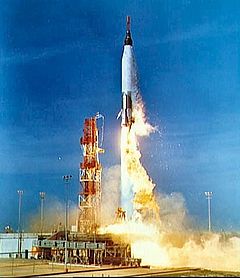
Mercury-Atlas 2
Encyclopedia

Mercury program
Mercury Program might refer to:*the first successful American manned spaceflight program, Project Mercury*an American post-rock band, The Mercury Program...
-Atlas
Atlas LV-3B
The Atlas LV-3B, Atlas D Mercury Launch Vehicle or Mercury-Atlas Launch Vehicle, was a man-rated expendable launch system used as part of the United States Project Mercury to send astronauts into low Earth orbit. It was derived from the SM-65D Atlas missile, and was a member of the Atlas family of...
2 (MA-2) was launched unmanned on February 21, 1961 at 14:10 UTC, from Launch Complex 14
Cape Canaveral Air Force Station Launch Complex 14
Launch Complex 14 is a launch site at Cape Canaveral Air Force Station, Florida. LC-14 was used for various manned and unmanned Atlas launches, including the Friendship 7 flight aboard which John Glenn became the first American to orbit the Earth....
at Cape Canaveral
Cape Canaveral
Cape Canaveral, from the Spanish Cabo Cañaveral, is a headland in Brevard County, Florida, United States, near the center of the state's Atlantic coast. Known as Cape Kennedy from 1963 to 1973, it lies east of Merritt Island, separated from it by the Banana River.It is part of a region known as the...
, Florida
Florida
Florida is a state in the southeastern United States, located on the nation's Atlantic and Gulf coasts. It is bordered to the west by the Gulf of Mexico, to the north by Alabama and Georgia and to the east by the Atlantic Ocean. With a population of 18,801,310 as measured by the 2010 census, it...
. Test objectives for this flight were concerned with the ability of the spacecraft to withstand reentry under the temperature-critical abort conditions and with the capability of the Atlas to meet the proper injection conditions. This Atlas "D" modified for the Mercury mission, was unique in the program in that it incorporated a stainless steel reinforcing band installed around the vehicle between stations 502 and 510. A thin sheet of asbestos was installed between the reinforcing band and the tank skin. This modification was installed as a precaution against the type of failure which had occurred on the previous MA-1 flight. MA-2 flew a successful suborbital mission that lasted 17 minutes 56 seconds. Altitude reached was 114 miles (183 km), speed, 13,227 mph (21,287 km/h). All test objectives were fully met. The capsule was recovered 1,432 miles (2305 km) downrange. Peak acceleration was 15.9 g (156 m/s²). Mass 1,154 kg.
Mercury spacecraft # 6 and Atlas # 67-D were used in the mission.
Mercury spacecraft # 6 used in the Mercury-Atlas 2 mission, is currently displayed at the Houston Museum of Natural Science, Houston, TX.

